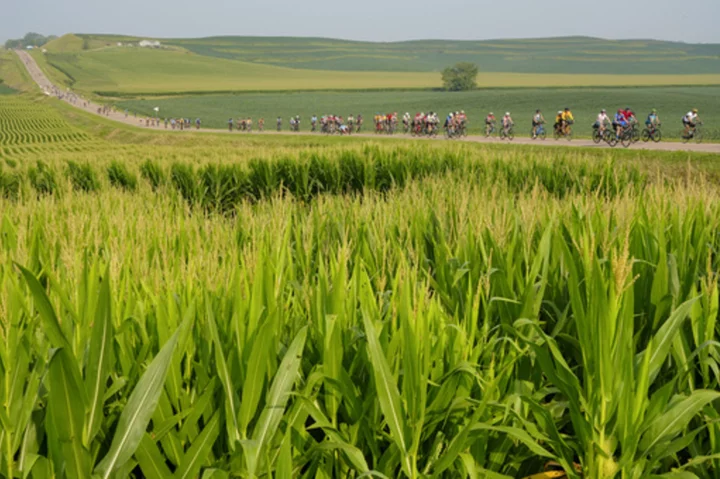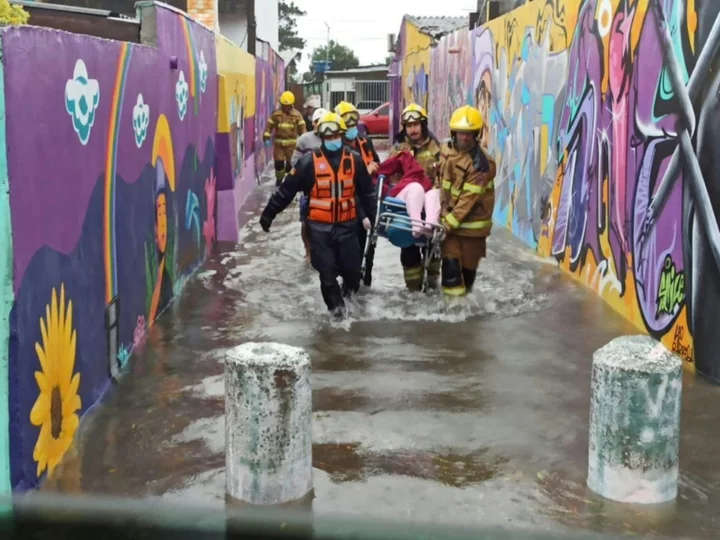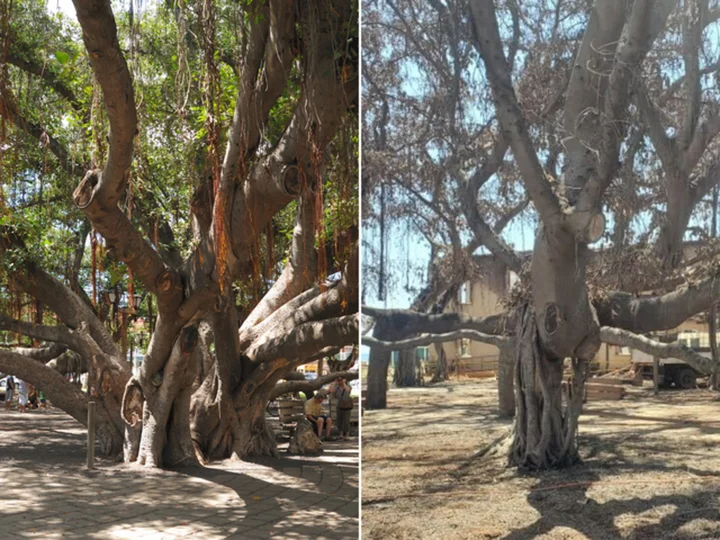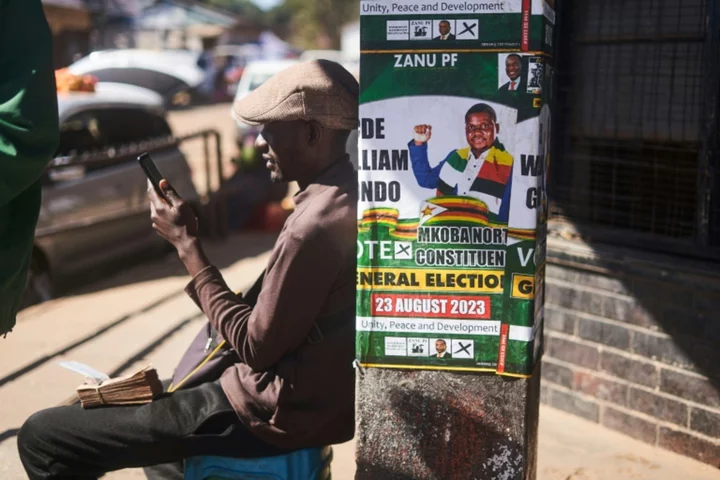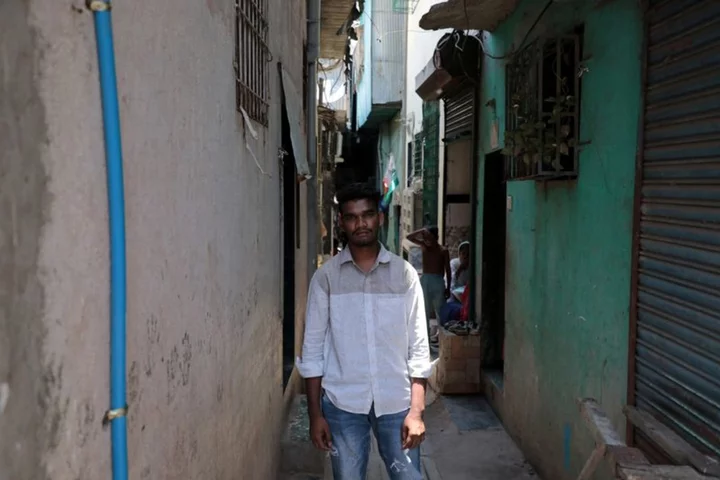SIOUX CITY, Iowa (AP) — What bills itself as “the world's longest, largest and oldest recreational bicycle touring event” was more like the world's biggest traffic jam Sunday as riders, packed together in a sinewy stream of brightly colored jerseys and shorts, churned across the Loess Hills on the western edge of Iowa.
It's called RAGBRAI — the Register’s Annual Great Bicycle Ride Across Iowa — and it promised to be bigger than ever this year, as the brainchild of two writers from The Des Moines Register celebrated its golden anniversary with a route similar to its first.
That meant a start in Sioux City, where ambitious riders ceremonially dipped their rear tires in the Missouri River, and a finish for those with the legs and the temerity to last that long seven days later in Davenport on the Mississippi River.
Along the way there is plenty of pie, more than enough beer, and countless spaghetti dinners served in church basements in tiny towns that dot the heartland. There are riders on bikes that cost the equivalent of a down payment on a house, others on hand-me-downs that announce their arrival with every creaking pedal stroke. The riders themselves come from all corners of the globe, including one intrepid group from Australia, and represent just about every U.S. state.
“Participating in RAGBRAI is an extraordinary experience. It’s truly a source of pride for many of us in the cycling community, especially if you call anywhere in Iowa home,” said Lisa Carponelli, who along with business partner Kim Hopkins used the ride in 2015 to help launch their business, Velorosa, which produces cycling gear for women.
“You’ll meet countless interesting people in every town and along every stretch of pavement," she said. "Everyone is participating in a great outdoor activity, and you’ll always have something to talk about: the weather, the hills — don’t think it’s only flat here — the scenery, bike issues, and where to find the best food and the coldest beer in every town.”
Oh, and Carponelli promises it will be hot. Temperatures during this year's 500-mile journey could hit triple digits.
So what exactly is the allure? Why has such a ride in Iowa, of all places, become an event that cuts across generations?
Mostly it boils down to the people.
Two of them, to start: John Karras, an avid cyclist and features writer for The Des Moines Register, and Don Kaul, who wrote a column called “Over The Coffee.” Karras thought it would be fun for Kaul to write his column as he crossed the state, so the two got the support of their editors and set off that first year — on August 26, 1973 — with about 300 people tagging along.
“The early years were great because they were freewheeling, so to speak. It was new. It was fun. It was unique,” said Bob Molsberry, who watched that first ride go through Iowa City as a college student and joined in the following year.
He will be riding part of RAGBRAI for the 30th time this year with his daughter and two grandchildren.
“Even Kaul and Karras were surprised at the response,” Molsberry said. “They had a couple of hundred show up that first year and didn't have hotels or anything. People just showed up. The second year they had a truck that carried our gear, but people were just kind of on their own. Then it grew up gradually as the bicycling craze caught on.”
The ride really took off during the 1980s, when Greg LeMond put American cycling on the map with his three triumphs at the Tour de France, and the 1990s, when Lance Armstrong — a frequent RAGBRAI rider — was wearing the yellow jersey.
Some of the quaintness of the ride has been lost, of course, as commercialism took root along the route. Some of the dedicated charters these days carry gear from town to town, cook food each night and even set up riders' tents before their arrival.
The charm of the ride still exists, though.
It was evident in the man pulling his kid in a wagon down the road, and the youngster doling out fruit snacks (two for a dollar) and granola bars to other weary riders. Or the riders that stopped just outside Sioux City to help a stranded rider helplessly holding his broken chain. Or the myriad teams that continue to rip the seats out of old school buses, paint them in often garish colors, pack them full of refreshments and set off down the road for a week in the Iowa sun.
The charm is evident in Victor Fassano, a retired sheet metal worker from New York, who decided he wanted to start doing “epic adventures” at this stage of his life. He was on his way to the start when the transmission in his group's car blew up. But rather than stew over the crater it just put in their wallets, the group's first thought was: How do I get to Iowa now?
After some frantic hours, they managed to rent a pickup truck with a hitch for their bike racks and were on their way.
“For me,” Fassano says, “as a kid having a bicycle was freedom. I wanted to get that feeling back as an adult. I ride in groups, which is so much fun, and every once in a while just heading out by yourself to clear my head is the best.”
There is no heading out by yourself this week.
There are 20,000 registered weeklong riders, and another 9,000 that have secured day passes. But they are joined by thousands more who crash the ride, which means there could be more than 50,000 on the road some days this week.
Get ready for more traffic jams.
Or just go slowly and enjoy the ride.
___
Dave Skretta is a Kansas City, Missouri-based AP Sports Writer who also has covered pro cycling since the 2012 Summer Olympics. Skretta grew up in Decorah, Iowa, and has ridden RAGBRAI many times, though this will be his first time putting in 80-mile days and then writing about it. He is providing periodic updates from the road. His total mileage on Day 1: 75.
___
AP Olympics: https://apnews.com/hub/2024-paris-olympic-games and https://twitter.com/AP_Sports

